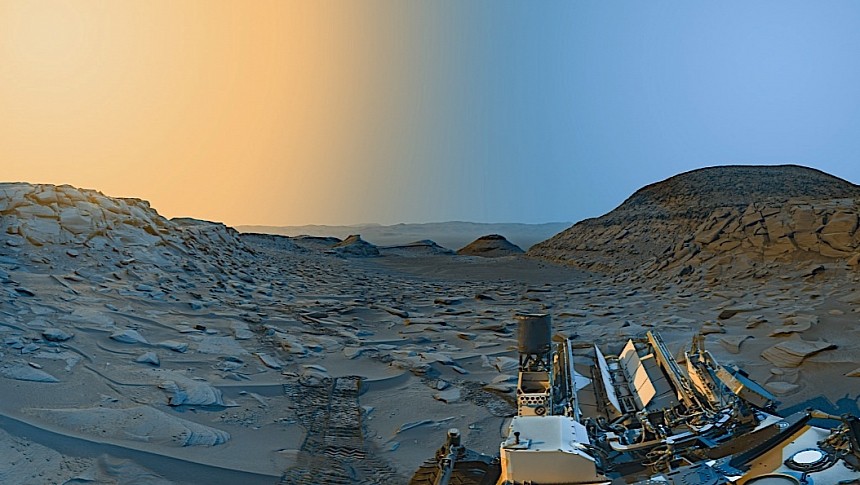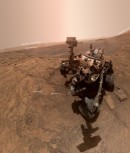Sometime in the not so distant future, humans will be able to witness with their own eyes how a sunrise or a sunset look like on Mars. True, no official mission to the Red Planet in planned yet, but we all know someday we will be going there.
Until that happens the only way we can experience the planet is through the images the rovers still on duty up there send back. There are just two of them still operational on Mars, the American Curiosity and Perseverance, but they seem more than enough to give us a proper sense of the place.
Being the newest and most modern means the Perseverance gets all the attention and prime time, but that doesn't mean the Curiosity is not capable of surprising us still.
Having landed on Mars more than a decade ago, in 2012, the Curiosity sent back home more than one million photographs of Mars since. Back in April, the machine was the recipient of a very long-distance over-the-air update, as NASA decided to make some 180 changes to how the rover operates. So chances are a lot more pictures from up there will come our way.
One of the most recent is pictured as the main photo of this story. It's a highly processed image of the Martian sunrise and sunset, as seen by the rover as it moved out of the Marker Band Valley.
The image was composed by NASA from two separate views the rover took back in April. We're talking about an “artistic interpretation” of what's there, with the image showing the view of the region on April 8 at 9:20 am and 3:40 pm, local time.
The Curiosity took the images using its navigation cameras, and those are black and white. For the ultimate effect, NASA people not only combined the two images, but also added color to really impact our senses.
On the right side of the pic we see the Martian landscape bathing in an orange light. That is the image the rover captured in the afternoon. On the right side, in blue, we see how the place looks like in the morning.
The terrain displayed in front of the machine reveals some of the features made famous over the years by humanity's exploration efforts on the Red Planet. We get glimpses of the 3-mile (5 km) high Mount Sharp, the Gale Crater, the Marker Band Valley, and two hills named Bolivar and Deepdale.
It's worth mentioning that when these pics were taken it was winter in this particular region of Mars, meaning a coating of low dust floats above the surface, adding depth to the entire vista.
For those passionate about the tech itself, there are also glimpses of some of the rover's own hardware, including the Radiation Assessment Detector (RAD), the three antennas, and the nuclear power source that keeps the machine running.
The Curiosity was initially meant to stay operational on Mars for just two years. More than a decade later, it's still kicking, so its mission has been extended indefinitely. And that means we should expect a lot more surprises such as this one coming our way.
Being the newest and most modern means the Perseverance gets all the attention and prime time, but that doesn't mean the Curiosity is not capable of surprising us still.
Having landed on Mars more than a decade ago, in 2012, the Curiosity sent back home more than one million photographs of Mars since. Back in April, the machine was the recipient of a very long-distance over-the-air update, as NASA decided to make some 180 changes to how the rover operates. So chances are a lot more pictures from up there will come our way.
One of the most recent is pictured as the main photo of this story. It's a highly processed image of the Martian sunrise and sunset, as seen by the rover as it moved out of the Marker Band Valley.
The image was composed by NASA from two separate views the rover took back in April. We're talking about an “artistic interpretation” of what's there, with the image showing the view of the region on April 8 at 9:20 am and 3:40 pm, local time.
The Curiosity took the images using its navigation cameras, and those are black and white. For the ultimate effect, NASA people not only combined the two images, but also added color to really impact our senses.
On the right side of the pic we see the Martian landscape bathing in an orange light. That is the image the rover captured in the afternoon. On the right side, in blue, we see how the place looks like in the morning.
The terrain displayed in front of the machine reveals some of the features made famous over the years by humanity's exploration efforts on the Red Planet. We get glimpses of the 3-mile (5 km) high Mount Sharp, the Gale Crater, the Marker Band Valley, and two hills named Bolivar and Deepdale.
It's worth mentioning that when these pics were taken it was winter in this particular region of Mars, meaning a coating of low dust floats above the surface, adding depth to the entire vista.
For those passionate about the tech itself, there are also glimpses of some of the rover's own hardware, including the Radiation Assessment Detector (RAD), the three antennas, and the nuclear power source that keeps the machine running.
The Curiosity was initially meant to stay operational on Mars for just two years. More than a decade later, it's still kicking, so its mission has been extended indefinitely. And that means we should expect a lot more surprises such as this one coming our way.







